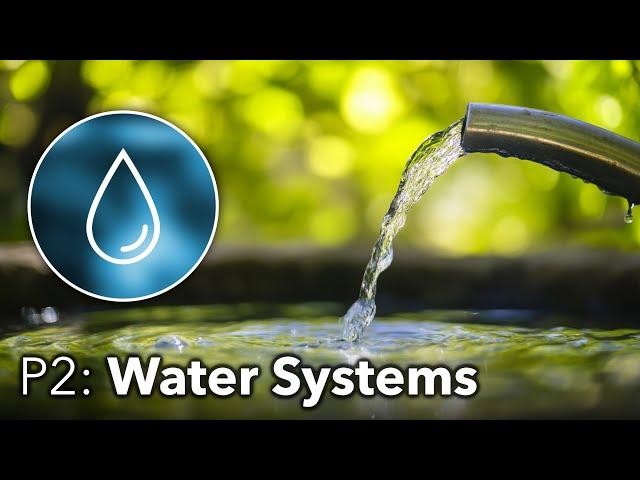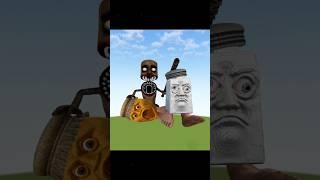
The Off Grid Guide - Part 2 | Water
Timestamps:
Intro 0:00
00:04 Modern Water Issues
Rainwater & Surface Water 14:43
Well, AWG Systems & Purification 28:13
Landscape for Water Retention 42:17
Checkout more of our articles on: https://articles.acornlandlabs.com/
Checkout the Land Lab Simulator on: https://landlab.app/simulator
Resources & links: 🔗
https://en.wikipedia.org/wiki/Ogallala_Aquifer
https://greywateraction.org/greywater-reuse/
Jackson water crisis forces residents to find alternatives https://apnews.com/article/floods-mississippi-jackson-e926f9faca6230777a4227b50f89e93a
Cape Town: Lessons from managing water scarcity
https://www.brookings.edu/articles/cape-town-lessons-from-managing-water-scarcity/
Our IBC Tote Source: https://atlantabarrels.com/
U.S. Water Supply and Distribution Factsheet
https://css.umich.edu/publications/factsheets/water/us-water-supply-and-distribution-factsheet
Building The Three Bucket Bio-Water-Filter
www.askaprepper.com/building-the-three-5-gallon-bucket-bio-water-filter/
California Aquifer Risk Map: https://gispublic.waterboards.ca.gov/portal/apps/webappviewer/index.html?id=17825b2b791d4004b547d316af7ac5cb
USA Groundwater Depletion data: https://www.americangeosciences.org/critical-issues/maps/groundwater-depletion-map-united-states
Compost increases the water holding capacity of droughty soils https://www.canr.msu.edu/news/compost_increases_the_water_holding_capacity_of_droughty_soils
Watch these two Sepp Holzer videos on his farm and water:
https://www.youtube.com/watch?v=5GMXqgQIU9c
Modern Water Issues in the USA 🇺🇸
The U.S. faces significant water challenges:
Drying Aquifers 🌵: Western aquifers are depleting due to droughts, corporate farming, and inefficient water use.
Extreme Weather 🌪️: Unpredictable weather, like droughts and heavy rain, complicates water management.
Water Pollution ☠️: Chemicals and agricultural runoff pollute water, especially in the East.
Agricultural Impact 🐄: Nitrates from fertilizers contaminate water supplies.
Runoff and Contaminants 🦠: Pollutants from urban and agricultural runoff harm water quality.
Reservoir Depletion 💧: Major reservoirs like Lake Mead are at risk, affecting water availability.
Water Wars: A Looming Concern 🌊
Increasing scarcity could lead to conflicts over water resources.
Conclusion: Water as a Precious Resource 🚰
We must manage water responsibly. At Acorn Land Lab, we focus on rainwater collection, efficient irrigation, and permaculture to address scarcity and pollution, securing water for the future.
Rainwater & Surface Water in Off-Grid Settings 🌧️
Rainwater Tanks:
Roof Selection: Tin roofs are best for clean rainwater; avoid asphalt.
First Flush Diverter: Use a system to divert initial rainwater, which may carry contaminants.
Tanks: IBC food-grade tanks are ideal for storing potable water.
Computing Water Needs:
Estimation: Calculate needs based on people and usage (10-100 gallons daily).
Factors: Rainfall frequency and duration without rain determine cistern size.
Collection Formula: Roof area (ft²) x precipitation (in) x 0.623 = gallons collected.
Key Considerations:
Water Pollution: Regularly clean systems to avoid contaminants.
Water Availability: Hybrid systems (rainwater, city, well) might be needed in some areas.
Surface Water Overview:
Sources: Creeks, streams, and ponds are key for supplying water.
Family Water Needs Example:
A family of four needs about 200 gallons daily, requiring a large roof area and cistern.
Understanding Aquifers 🌎
Aquifers store groundwater. Their stability is crucial for sustainable use and can be assessed with risk maps.
Well Systems 🕳️
Depth: Most wells range from 100 to 800 feet. Deeper wells usually provide better water quality.
Costs: Drilling a well can cost between $3,500 and $15,000.
Well Maintenance: Annual checks are vital to ensure water safety.
Combining Rainwater and Well Systems 🌧️
Using both rainwater and well water provides a reliable supply, with rainwater as the primary source and wells as backup.
Energy and Water ⚡
Water and energy are linked; producing and treating water requires significant energy, making efficient water use essential.
Atmospheric Water Generators (AWGs) ☁️
AWGs extract water from the air, providing an alternative but energy-intensive water source.
Water Purification Options 🏡
Gravity-Fed Systems: Easy and portable but slow.
Reverse Osmosis: Effective at removing contaminants but wastes water.
Sediment Filters: Good for large particles, not chemicals.
UV Filters: Kills pathogens but requires electricity.
Carbon Filters: Improves taste, limited chemical removal.
Distillers: Purify water but are slow and need electricity.
Choosing the Right System: Select based on needs and water quality. Combining systems offers better protection.
Intro 0:00
00:04 Modern Water Issues
Rainwater & Surface Water 14:43
Well, AWG Systems & Purification 28:13
Landscape for Water Retention 42:17
Checkout more of our articles on: https://articles.acornlandlabs.com/
Checkout the Land Lab Simulator on: https://landlab.app/simulator
Resources & links: 🔗
https://en.wikipedia.org/wiki/Ogallala_Aquifer
https://greywateraction.org/greywater-reuse/
Jackson water crisis forces residents to find alternatives https://apnews.com/article/floods-mississippi-jackson-e926f9faca6230777a4227b50f89e93a
Cape Town: Lessons from managing water scarcity
https://www.brookings.edu/articles/cape-town-lessons-from-managing-water-scarcity/
Our IBC Tote Source: https://atlantabarrels.com/
U.S. Water Supply and Distribution Factsheet
https://css.umich.edu/publications/factsheets/water/us-water-supply-and-distribution-factsheet
Building The Three Bucket Bio-Water-Filter
www.askaprepper.com/building-the-three-5-gallon-bucket-bio-water-filter/
California Aquifer Risk Map: https://gispublic.waterboards.ca.gov/portal/apps/webappviewer/index.html?id=17825b2b791d4004b547d316af7ac5cb
USA Groundwater Depletion data: https://www.americangeosciences.org/critical-issues/maps/groundwater-depletion-map-united-states
Compost increases the water holding capacity of droughty soils https://www.canr.msu.edu/news/compost_increases_the_water_holding_capacity_of_droughty_soils
Watch these two Sepp Holzer videos on his farm and water:
https://www.youtube.com/watch?v=5GMXqgQIU9c
Modern Water Issues in the USA 🇺🇸
The U.S. faces significant water challenges:
Drying Aquifers 🌵: Western aquifers are depleting due to droughts, corporate farming, and inefficient water use.
Extreme Weather 🌪️: Unpredictable weather, like droughts and heavy rain, complicates water management.
Water Pollution ☠️: Chemicals and agricultural runoff pollute water, especially in the East.
Agricultural Impact 🐄: Nitrates from fertilizers contaminate water supplies.
Runoff and Contaminants 🦠: Pollutants from urban and agricultural runoff harm water quality.
Reservoir Depletion 💧: Major reservoirs like Lake Mead are at risk, affecting water availability.
Water Wars: A Looming Concern 🌊
Increasing scarcity could lead to conflicts over water resources.
Conclusion: Water as a Precious Resource 🚰
We must manage water responsibly. At Acorn Land Lab, we focus on rainwater collection, efficient irrigation, and permaculture to address scarcity and pollution, securing water for the future.
Rainwater & Surface Water in Off-Grid Settings 🌧️
Rainwater Tanks:
Roof Selection: Tin roofs are best for clean rainwater; avoid asphalt.
First Flush Diverter: Use a system to divert initial rainwater, which may carry contaminants.
Tanks: IBC food-grade tanks are ideal for storing potable water.
Computing Water Needs:
Estimation: Calculate needs based on people and usage (10-100 gallons daily).
Factors: Rainfall frequency and duration without rain determine cistern size.
Collection Formula: Roof area (ft²) x precipitation (in) x 0.623 = gallons collected.
Key Considerations:
Water Pollution: Regularly clean systems to avoid contaminants.
Water Availability: Hybrid systems (rainwater, city, well) might be needed in some areas.
Surface Water Overview:
Sources: Creeks, streams, and ponds are key for supplying water.
Family Water Needs Example:
A family of four needs about 200 gallons daily, requiring a large roof area and cistern.
Understanding Aquifers 🌎
Aquifers store groundwater. Their stability is crucial for sustainable use and can be assessed with risk maps.
Well Systems 🕳️
Depth: Most wells range from 100 to 800 feet. Deeper wells usually provide better water quality.
Costs: Drilling a well can cost between $3,500 and $15,000.
Well Maintenance: Annual checks are vital to ensure water safety.
Combining Rainwater and Well Systems 🌧️
Using both rainwater and well water provides a reliable supply, with rainwater as the primary source and wells as backup.
Energy and Water ⚡
Water and energy are linked; producing and treating water requires significant energy, making efficient water use essential.
Atmospheric Water Generators (AWGs) ☁️
AWGs extract water from the air, providing an alternative but energy-intensive water source.
Water Purification Options 🏡
Gravity-Fed Systems: Easy and portable but slow.
Reverse Osmosis: Effective at removing contaminants but wastes water.
Sediment Filters: Good for large particles, not chemicals.
UV Filters: Kills pathogens but requires electricity.
Carbon Filters: Improves taste, limited chemical removal.
Distillers: Purify water but are slow and need electricity.
Choosing the Right System: Select based on needs and water quality. Combining systems offers better protection.
Комментарии:
The Off Grid Guide - Part 2 | Water
Acorn Land Labs
Technology is replacing jobs. Are you ready?
CNN Business










![[신약워밍업03] 헤롯이 유언장을 6번이나 고친 이유 #하마성경 [정은수tv] [신약워밍업03] 헤롯이 유언장을 6번이나 고친 이유 #하마성경 [정은수tv]](https://rtube.cc/img/upload/RV8wbEYyS1pTWEc.jpg)















